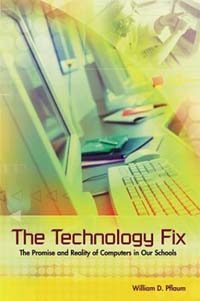| Pflaum claims he began his journey with an open mind, and to his credit, the tone and content of his book seems to substantiate this point of view. He had no apparent ax to grind, no pre-conceptions or hidden agendas.
He simply wanted to find out what people were doing with all the equipment they had bought and installed.
In every building he kept asking an essential question. "Do you have any evidence that this technology has improved student performance?"
Sadly, he never finds a school with a satisfying answer.
Even though he reports individual classroom activities that seem well organized and valuable, most of what he describes is disappointing. He organizes schools into three categories ranging from relatively well organized programs to those with little coherence or value. He is compassionate - even forgiving - as he describes his visits and the frequently sad events he witnesses.
Unlike Oppenheimer, Pflaum does not name names of schools or teachers. He masks identities and is quick to point out constraints, bureaucratic obstacles and system failures that partially excuse the schools for the shortcomings he witnesses. Unlike Oppenheimer, he does not blame technology for the problems he sees. He sees the challenge as one of strategy and purpose:
- The choice is not to reject technology or to embrace it, rather to use it with thought and discrimination.
- Page 180
-
Some Especially Important Findings
There are two books here. One is Pflaum's observations. He is witty, charming and often quite compassionate. He has a fine eye for details, a sharp sense of irony and a future as a novelist. Anyone wondering how well we have done with this stage of technology adoption will find his visits worth reading by themselves.
A second book is Pflaum's conclusions and recommendations. While I part company with him on many of his policy suggestions, I find these sections earnest and thoughtful, well worth considering as schools try to invent the next generation of technology use.
I reproduce here a short list of observations I found especially important:
- The focus of many schools on high stakes testing and content has set up a conflict between the possibilities of doing project-based learning and addressing the tests. Technology is seen as a distraction by many from the more important business at hand.
- Schools and leaders can have good rhetoric and good intentions without accomplishing much of value.
- Sustained progress requires sustained funding and resources.
- There is too little attention devoted to assessment.
- There are too many computers that are not turned on (approaching 80% during his visits).
- There are many teachers using technologies in ways that may not be worthy (such as PowerPointlessness) who think they are doing good work.
A Number of Recommendations
Pflaum makes four suggestions to shift practice in a better direction:
- Focus computer use on students who will benefit most; don't dilute the value of computers by insisting that all students have equal access time.
- Use computers to support the alignment of standards, instruction, and assessment.
- Use computers for assessment, benefit from their ability to correct tests automatically and provide results quickly.
- Teach students to use productivity tools and the Internet but wait until students are ready; coordinate such teaching within and across grade levels.
The Technology Fix is important reading for those who hope to steer schools and districts forward beyond the inconsequential first stages of networking to something more substantial. Pflaum does a good job of identifying the questions and the issues.
The answers depend, ultimately, upon the local leaders.
|
 From Now On
From Now On
